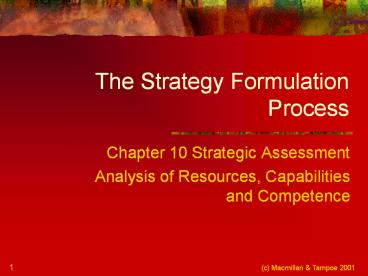The Strategy Formulation Process - PowerPoint PPT Presentation
1 / 15
Title:
The Strategy Formulation Process
Description:
Knowledge based, person specific. professional service. Rule or process based. provision, of knowledge & functionality. CORE COMPETENCE ... – PowerPoint PPT presentation
Number of Views:175
Avg rating:3.0/5.0
Title: The Strategy Formulation Process
1
The Strategy Formulation Process
- Chapter 10 Strategic Assessment
- Analysis of Resources, Capabilities and
Competence
2
Figure 10.1 Some commonly used techniques for
internal analysis
Single Businesses Resource Audit (10.2) Analysis
of cost and profit (10.3) Benchmarking
(10.4) Value Chain Analysis (10.5) Supply Chain
Analysis(10.6)
Both Single and Multiple Businesses Core
Competencies (10.7) Shareholder Value Analysis
(10.8) Distinctive Organisational Capabilities
(10.9)
Multiple Businesses Assessing Parenting
Advantage (10.10) Portfolio Analysis (10.11)
3
Resource Audit
- Resources
- Physical
- Human
- Financial
- Other
- Quality and Quantity
- Unique resources
- A good initial analysis
4
Analysis of Costs and Profit
- Current sources of profits and trends
- Recast standard reporting to give new insights
- Pragmatic approach to get value from time and
effort spent - A good initial analysis
5
Benchmarking
- Objective comparison with best in class
- Benchmarking clubs common
- Simple in theory - Hard in practice
- Observed differences in performance may be due
to differences in parameters - Qualitative observations may be more valuable
than quantitative
6
Value Chain Analysis
- Basic Value chain in Fig. 10.2
- Elegant in theory
- Time-consuming in practice
- Revised value chain to reflect power of people
and knowledge
7
Figure 10.3 Revised Value Chain
Firms infrastructure
SUPPORT ACTIVITIES
Technology trapping and commercialisation
Strategic Management
INFORMATION SYSTEMS KNOWLEDGE MANAGEMENT
technical, management, marketing, sales, productio
n
price, place, promotion product service
basic skills, know-how, technologies strategic
assets
revenue, profit, market share,
customer satisfaction, loyalty
PRIMARY ACTIVITIES
core competence
HUMAN RESOURCE MANAGEMENT
PROCUREMENT AND SUPPLIER MANAGEMENT
Source adapted from Porter, M (1985), Martin
(1995) to reflect recent developments
8
Figure 10.4 The Core Competence Perspective
Traditional Perspective
Core Competence Perspective
Market share of present markets Share of future
opportunities Strategic Business Unit
Focus Corporate Competence Stand-alone Patte
rn of alliances Speed to Market Perseverance
towards long-term vision
Adapted from Hamel, G Prahalad, C.K. (1994)
Competing for the Future
9
The Tests for Core Competence
- Essential to corporate survival in short and long
term - Invisible to competitors
- Difficult to imitate
- Unique to the enterprise
- Result from a mix of skills, resources and
processes - A capability which the organization can sustain
over time - Greater than the competence of an individual
- Essential to the development of core products
- Essential to the implementation of strategic
intent - Essential to the strategic choices of the
enterprise - Marketable and commercially viable
- Few in number
10
Figure 10.5 The roots of core competence for a
typical manufacturing business
(C) Mahen Tampoe February 6, 1996
11
Figure 10.6 The roots of core competence for
typical professional services firms
(C) Mahen Tampoe February 6, 1996
12
Figure 10.7 Applying Shareholder Value Analysis
Adapted from Rappaport (1986)
13
Assessing Parenting Advantage
- Stand-alone influence
- Linkage influence
- Central functions and service
- Corporate development
14
Figure 10.9 Portfolio Analysis
Source Originally Boston Consulting Group. In
Widespread use
15
Choosing the right tools for internal analysis
- Start with simple techniques
- Consider all tools and identify those likely to
be useful - Define the competitive capabilities the
enterprise needs - Identify the subsystems which support these
capabilities - Identify core competence relative to competitive
capabilities - Determine changes to enhance/improve core
competence - Take a systemic view
- Adjust the methods of analysis in the light of
what is found































